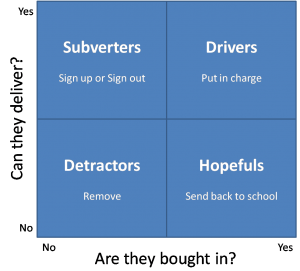Here’s a challenge. You have to get your organization to work in new ways but your workforce is well versed and even committed to the old ways. Sound familiar?
Many leaders are finding themselves in this position. They have a vision but can’t seem to get it executed.
Certainly, sometimes the issue is the leader. There is no shortage of people who are put into leadership positions without regard to whether they can actually lead others.
But, there is another major problem: Leaders who get their vision hijacked. The leader often exacerbates the problem. He or she tries to give the hijackers a break or a chance to turn things around. The problem is that they seldom do.
There are two kinds of people who hijack a vision: those who can’t do it and those who won’t do it.
The first group is a reality of the business environment. Things change. New ways of doing business, new assumptions, and new technologies all make it harder for the workforce as a whole to stay relevant. While not ideal, this first group can be turned around.
The second group is more problematic. This isn’t about simple motivation (e.g, reward strategies, recognition, etc.) This group doesn’t buy into the vision and actively tries to subvert it.
If you are serious about changing culture or implementing a vision, you need to figure out where your people fall.
Taking the two questions, “Can this person get it done?” and “Does this person want to get it done?” yields four possible results. Once you know where your people fit, you need to take action.
Drivers
Drivers are the people who can and want to implement your vision. They should be running your most critical initiatives. Give them the resources, latitude, and support to deliver.
Detractors
Detractors can’t deliver the vision and don’t care to anyway. You need to move them out of your organization as quickly as possible.
Often leaders make the mistake of letting these people linger. They assume that while they aren’t driving the vision, they might be helpful for lower level work. That’s not the case. This group winds up draining your resources and energy. Having no one in their place is better than keeping them around.
Subverters
Subverters are the most dangerous group. They are skilled and can get things done. They probably have a lot of influence. The problem is that they are using that against you.
Subverters can add value if they come around. So, that’s your action. You need to give them the chance to sign up or sign out. But, you need to do it quickly.
While they are deciding which option they want, they shouldn’t be put on critical tasks. This might sound counter-intuitive. The reality is that an average performer who is bought in will often out perform a super star who is not.
Don’t reward these people by letting them stay in the spotlight. Until they decide whether they want to be in, assign them to operational or maintenance tasks.
Hopefuls
Hopefuls want to deliver your vision but don’t have the skills to do so. Like the subverters, these people should be given a chance. However, you don’t have to be as aggressive.
Help them retool. Support them. Put them roles learning from the drivers.
These people are the core of your future workforce and deserve a chance. Help them out but be realistic as well. If after reasonable effort, they still can’t deliver, they might be a mismatch for your organization.
It’s both natural and admirable to want to give people the benefit of the doubt. And you should. But, you need to do so in a measured, purposeful way. Too many leaders watch their vision stagnate while waiting for people to turn around.
——————
Brad Kolar is an executive consultant, speaker, and author with Avail Advisors. Brad can be reached at brad.kolar@availadvisors.com


